Contemporary Recruitment and Employment Vacancy Advertisements Report
VerifiedAdded on 2021/04/21
|10
|3244
|35
Report
AI Summary
This report delves into the realm of Human Resource Management, specifically focusing on contemporary recruitment strategies and the role of employment vacancy advertisements in attracting potential candidates. The report begins with an introduction to recruitment, highlighting its significance in the HR system, followed by a conceptual framework that explores advertising's role in recruitment, distinguishing between traditional and contemporary advertising methods, and examining employment vacancy advertisements. A comprehensive literature review examines various recruitment practices, including the use of company websites, recruitment websites, and the impact of organizational image and job characteristics on applicant attraction. The methodology section details the qualitative research approach, utilizing both primary and secondary data sources, with a focus on online job advertisements from Seek.com. The data analysis will be conducted using thematic analysis. The report concludes with a Gantt chart outlining the research timeline, and references.
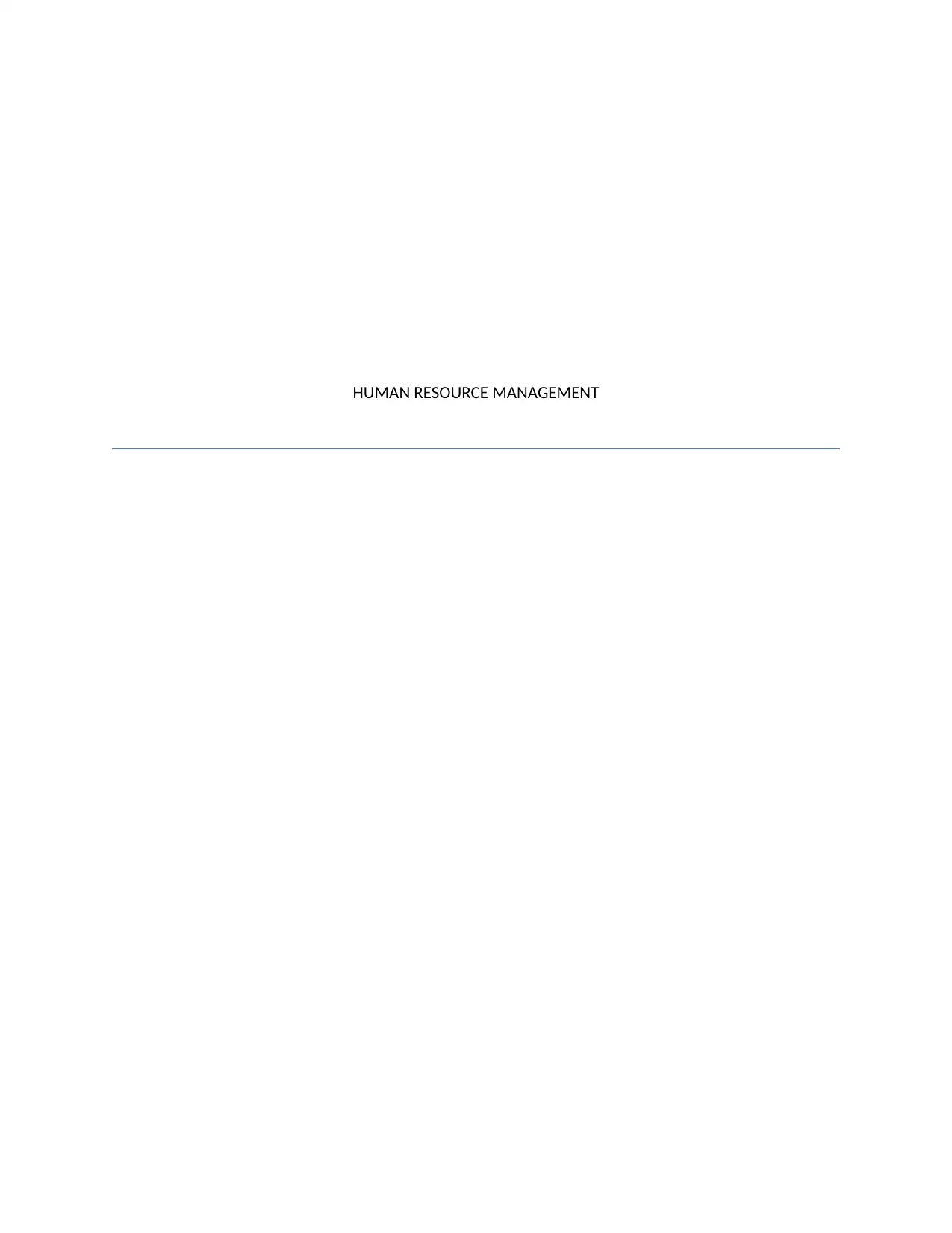
HUMAN RESOURCE MANAGEMENT
Paraphrase This Document
Need a fresh take? Get an instant paraphrase of this document with our AI Paraphraser
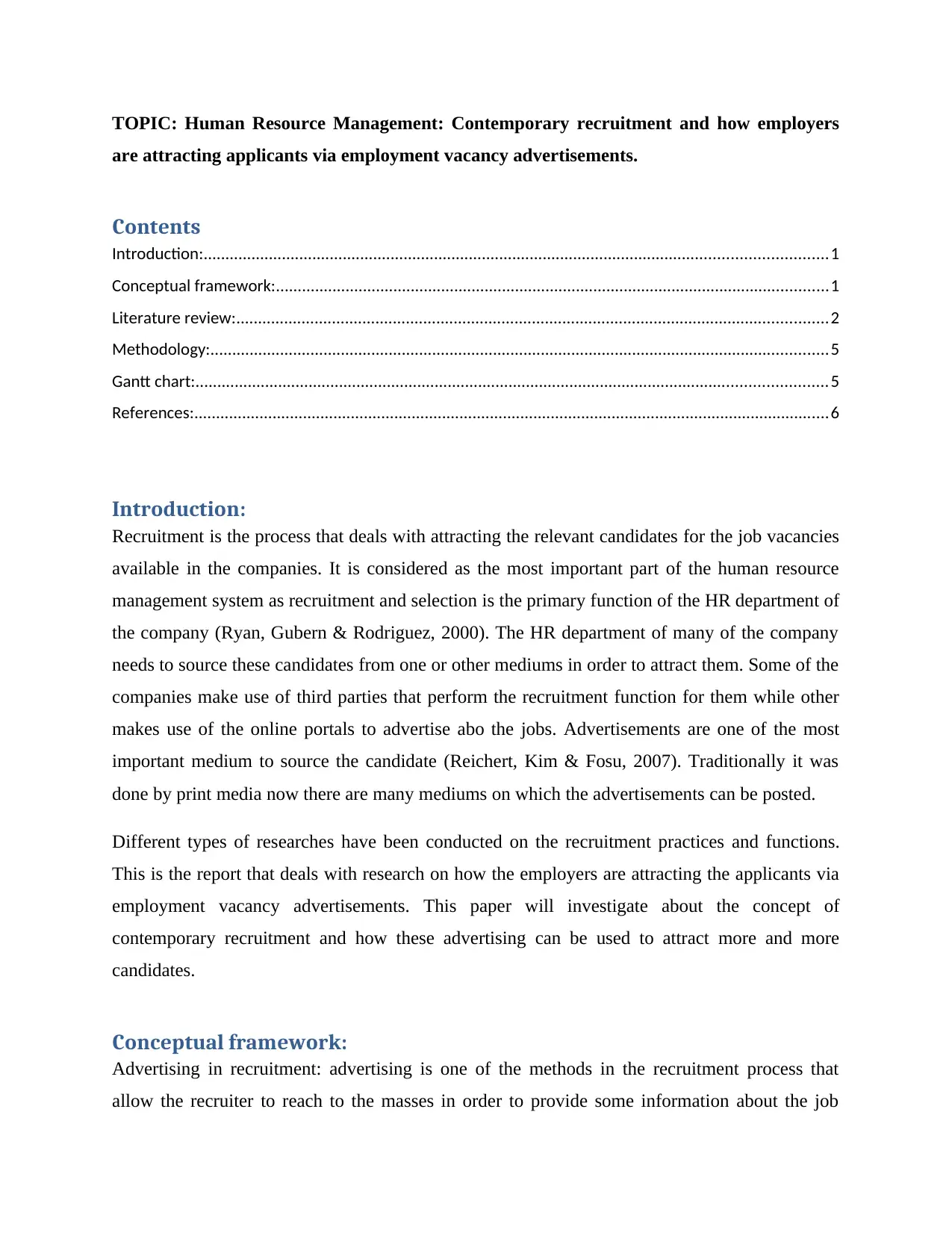
TOPIC: Human Resource Management: Contemporary recruitment and how employers
are attracting applicants via employment vacancy advertisements.
Contents
Introduction:...............................................................................................................................................1
Conceptual framework:...............................................................................................................................1
Literature review:........................................................................................................................................2
Methodology:..............................................................................................................................................5
Gantt chart:.................................................................................................................................................5
References:..................................................................................................................................................6
Introduction:
Recruitment is the process that deals with attracting the relevant candidates for the job vacancies
available in the companies. It is considered as the most important part of the human resource
management system as recruitment and selection is the primary function of the HR department of
the company (Ryan, Gubern & Rodriguez, 2000). The HR department of many of the company
needs to source these candidates from one or other mediums in order to attract them. Some of the
companies make use of third parties that perform the recruitment function for them while other
makes use of the online portals to advertise abo the jobs. Advertisements are one of the most
important medium to source the candidate (Reichert, Kim & Fosu, 2007). Traditionally it was
done by print media now there are many mediums on which the advertisements can be posted.
Different types of researches have been conducted on the recruitment practices and functions.
This is the report that deals with research on how the employers are attracting the applicants via
employment vacancy advertisements. This paper will investigate about the concept of
contemporary recruitment and how these advertising can be used to attract more and more
candidates.
Conceptual framework:
Advertising in recruitment: advertising is one of the methods in the recruitment process that
allow the recruiter to reach to the masses in order to provide some information about the job
are attracting applicants via employment vacancy advertisements.
Contents
Introduction:...............................................................................................................................................1
Conceptual framework:...............................................................................................................................1
Literature review:........................................................................................................................................2
Methodology:..............................................................................................................................................5
Gantt chart:.................................................................................................................................................5
References:..................................................................................................................................................6
Introduction:
Recruitment is the process that deals with attracting the relevant candidates for the job vacancies
available in the companies. It is considered as the most important part of the human resource
management system as recruitment and selection is the primary function of the HR department of
the company (Ryan, Gubern & Rodriguez, 2000). The HR department of many of the company
needs to source these candidates from one or other mediums in order to attract them. Some of the
companies make use of third parties that perform the recruitment function for them while other
makes use of the online portals to advertise abo the jobs. Advertisements are one of the most
important medium to source the candidate (Reichert, Kim & Fosu, 2007). Traditionally it was
done by print media now there are many mediums on which the advertisements can be posted.
Different types of researches have been conducted on the recruitment practices and functions.
This is the report that deals with research on how the employers are attracting the applicants via
employment vacancy advertisements. This paper will investigate about the concept of
contemporary recruitment and how these advertising can be used to attract more and more
candidates.
Conceptual framework:
Advertising in recruitment: advertising is one of the methods in the recruitment process that
allow the recruiter to reach to the masses in order to provide some information about the job
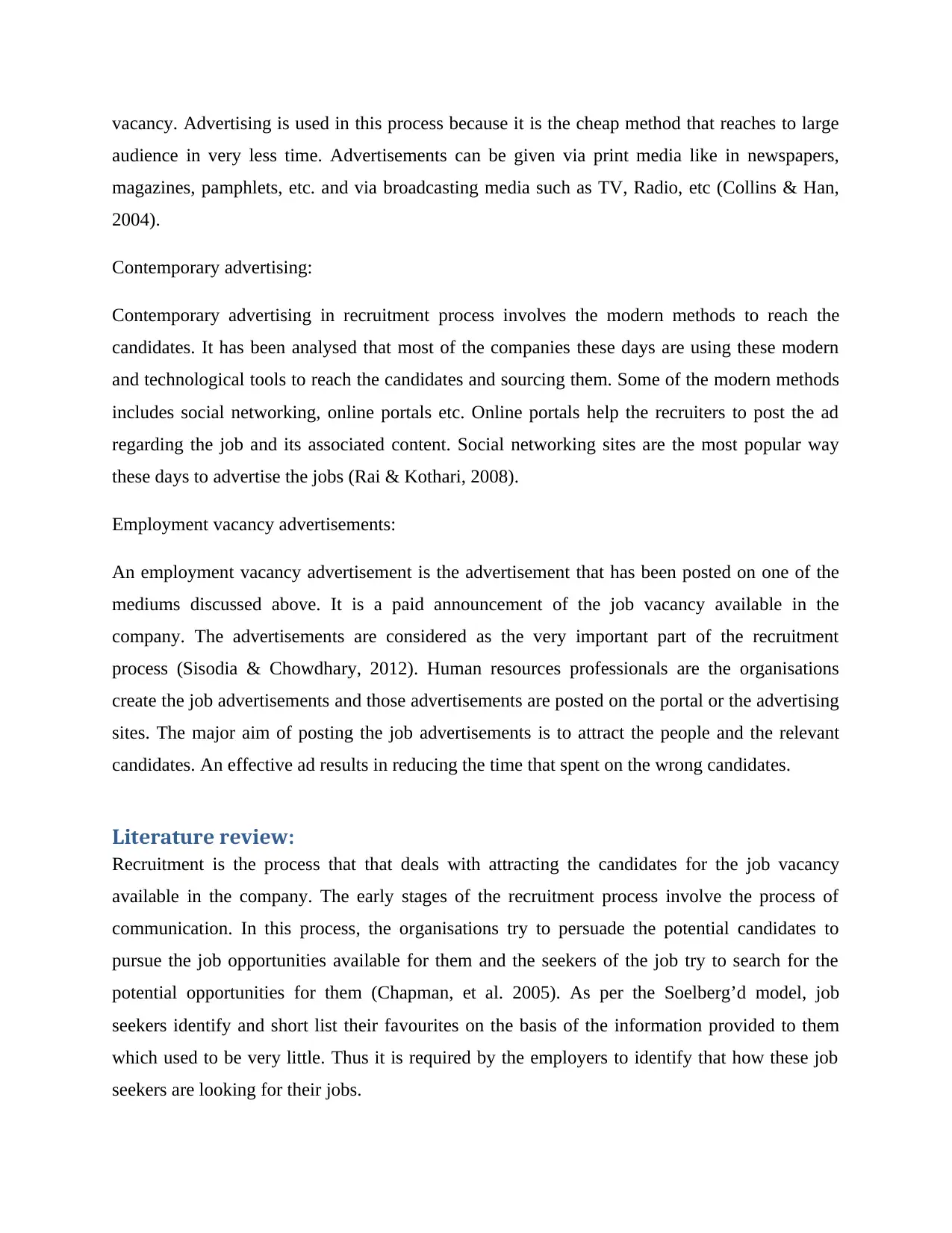
vacancy. Advertising is used in this process because it is the cheap method that reaches to large
audience in very less time. Advertisements can be given via print media like in newspapers,
magazines, pamphlets, etc. and via broadcasting media such as TV, Radio, etc (Collins & Han,
2004).
Contemporary advertising:
Contemporary advertising in recruitment process involves the modern methods to reach the
candidates. It has been analysed that most of the companies these days are using these modern
and technological tools to reach the candidates and sourcing them. Some of the modern methods
includes social networking, online portals etc. Online portals help the recruiters to post the ad
regarding the job and its associated content. Social networking sites are the most popular way
these days to advertise the jobs (Rai & Kothari, 2008).
Employment vacancy advertisements:
An employment vacancy advertisement is the advertisement that has been posted on one of the
mediums discussed above. It is a paid announcement of the job vacancy available in the
company. The advertisements are considered as the very important part of the recruitment
process (Sisodia & Chowdhary, 2012). Human resources professionals are the organisations
create the job advertisements and those advertisements are posted on the portal or the advertising
sites. The major aim of posting the job advertisements is to attract the people and the relevant
candidates. An effective ad results in reducing the time that spent on the wrong candidates.
Literature review:
Recruitment is the process that that deals with attracting the candidates for the job vacancy
available in the company. The early stages of the recruitment process involve the process of
communication. In this process, the organisations try to persuade the potential candidates to
pursue the job opportunities available for them and the seekers of the job try to search for the
potential opportunities for them (Chapman, et al. 2005). As per the Soelberg’d model, job
seekers identify and short list their favourites on the basis of the information provided to them
which used to be very little. Thus it is required by the employers to identify that how these job
seekers are looking for their jobs.
audience in very less time. Advertisements can be given via print media like in newspapers,
magazines, pamphlets, etc. and via broadcasting media such as TV, Radio, etc (Collins & Han,
2004).
Contemporary advertising:
Contemporary advertising in recruitment process involves the modern methods to reach the
candidates. It has been analysed that most of the companies these days are using these modern
and technological tools to reach the candidates and sourcing them. Some of the modern methods
includes social networking, online portals etc. Online portals help the recruiters to post the ad
regarding the job and its associated content. Social networking sites are the most popular way
these days to advertise the jobs (Rai & Kothari, 2008).
Employment vacancy advertisements:
An employment vacancy advertisement is the advertisement that has been posted on one of the
mediums discussed above. It is a paid announcement of the job vacancy available in the
company. The advertisements are considered as the very important part of the recruitment
process (Sisodia & Chowdhary, 2012). Human resources professionals are the organisations
create the job advertisements and those advertisements are posted on the portal or the advertising
sites. The major aim of posting the job advertisements is to attract the people and the relevant
candidates. An effective ad results in reducing the time that spent on the wrong candidates.
Literature review:
Recruitment is the process that that deals with attracting the candidates for the job vacancy
available in the company. The early stages of the recruitment process involve the process of
communication. In this process, the organisations try to persuade the potential candidates to
pursue the job opportunities available for them and the seekers of the job try to search for the
potential opportunities for them (Chapman, et al. 2005). As per the Soelberg’d model, job
seekers identify and short list their favourites on the basis of the information provided to them
which used to be very little. Thus it is required by the employers to identify that how these job
seekers are looking for their jobs.
⊘ This is a preview!⊘
Do you want full access?
Subscribe today to unlock all pages.

Trusted by 1+ million students worldwide
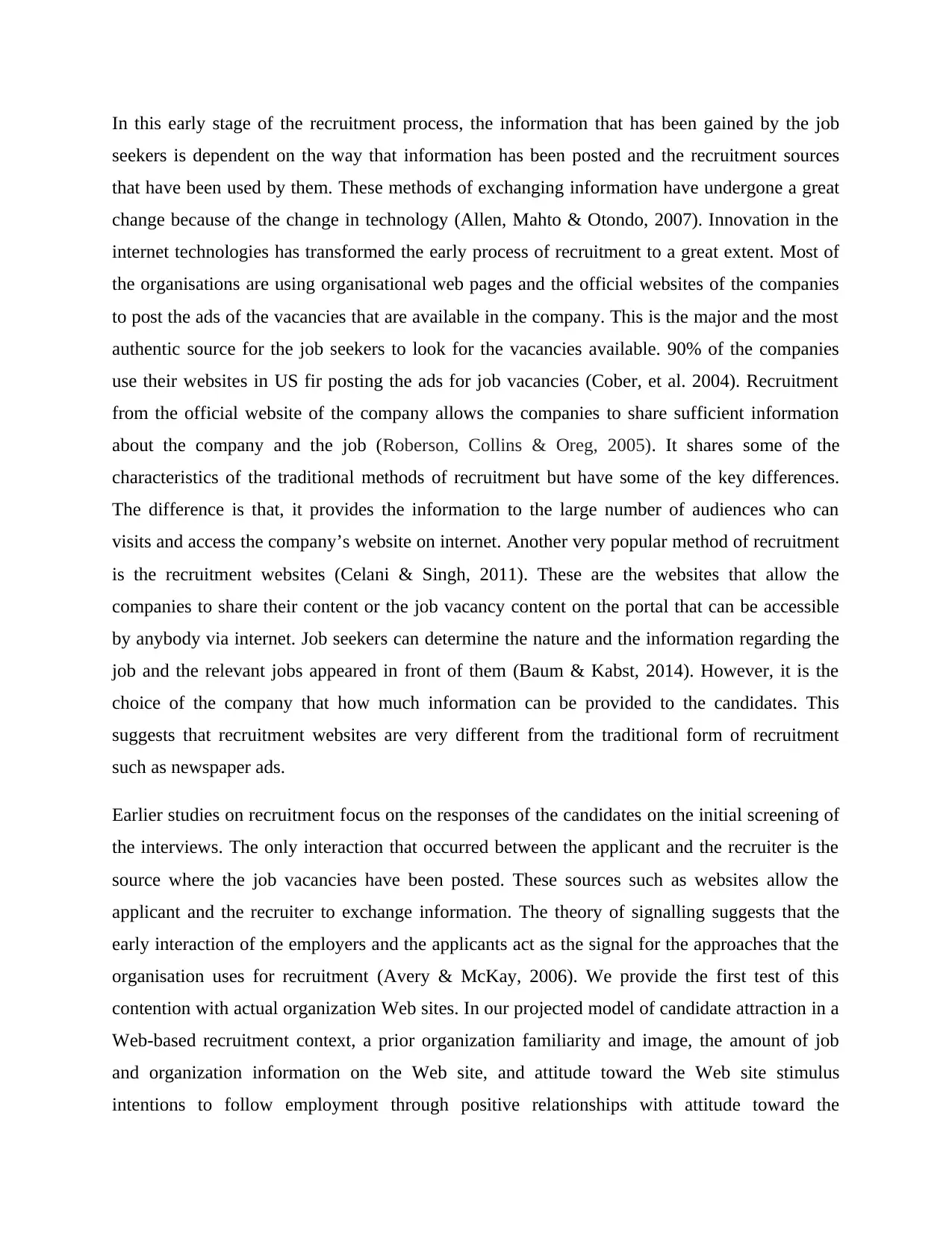
In this early stage of the recruitment process, the information that has been gained by the job
seekers is dependent on the way that information has been posted and the recruitment sources
that have been used by them. These methods of exchanging information have undergone a great
change because of the change in technology (Allen, Mahto & Otondo, 2007). Innovation in the
internet technologies has transformed the early process of recruitment to a great extent. Most of
the organisations are using organisational web pages and the official websites of the companies
to post the ads of the vacancies that are available in the company. This is the major and the most
authentic source for the job seekers to look for the vacancies available. 90% of the companies
use their websites in US fir posting the ads for job vacancies (Cober, et al. 2004). Recruitment
from the official website of the company allows the companies to share sufficient information
about the company and the job (Roberson, Collins & Oreg, 2005). It shares some of the
characteristics of the traditional methods of recruitment but have some of the key differences.
The difference is that, it provides the information to the large number of audiences who can
visits and access the company’s website on internet. Another very popular method of recruitment
is the recruitment websites (Celani & Singh, 2011). These are the websites that allow the
companies to share their content or the job vacancy content on the portal that can be accessible
by anybody via internet. Job seekers can determine the nature and the information regarding the
job and the relevant jobs appeared in front of them (Baum & Kabst, 2014). However, it is the
choice of the company that how much information can be provided to the candidates. This
suggests that recruitment websites are very different from the traditional form of recruitment
such as newspaper ads.
Earlier studies on recruitment focus on the responses of the candidates on the initial screening of
the interviews. The only interaction that occurred between the applicant and the recruiter is the
source where the job vacancies have been posted. These sources such as websites allow the
applicant and the recruiter to exchange information. The theory of signalling suggests that the
early interaction of the employers and the applicants act as the signal for the approaches that the
organisation uses for recruitment (Avery & McKay, 2006). We provide the first test of this
contention with actual organization Web sites. In our projected model of candidate attraction in a
Web-based recruitment context, a prior organization familiarity and image, the amount of job
and organization information on the Web site, and attitude toward the Web site stimulus
intentions to follow employment through positive relationships with attitude toward the
seekers is dependent on the way that information has been posted and the recruitment sources
that have been used by them. These methods of exchanging information have undergone a great
change because of the change in technology (Allen, Mahto & Otondo, 2007). Innovation in the
internet technologies has transformed the early process of recruitment to a great extent. Most of
the organisations are using organisational web pages and the official websites of the companies
to post the ads of the vacancies that are available in the company. This is the major and the most
authentic source for the job seekers to look for the vacancies available. 90% of the companies
use their websites in US fir posting the ads for job vacancies (Cober, et al. 2004). Recruitment
from the official website of the company allows the companies to share sufficient information
about the company and the job (Roberson, Collins & Oreg, 2005). It shares some of the
characteristics of the traditional methods of recruitment but have some of the key differences.
The difference is that, it provides the information to the large number of audiences who can
visits and access the company’s website on internet. Another very popular method of recruitment
is the recruitment websites (Celani & Singh, 2011). These are the websites that allow the
companies to share their content or the job vacancy content on the portal that can be accessible
by anybody via internet. Job seekers can determine the nature and the information regarding the
job and the relevant jobs appeared in front of them (Baum & Kabst, 2014). However, it is the
choice of the company that how much information can be provided to the candidates. This
suggests that recruitment websites are very different from the traditional form of recruitment
such as newspaper ads.
Earlier studies on recruitment focus on the responses of the candidates on the initial screening of
the interviews. The only interaction that occurred between the applicant and the recruiter is the
source where the job vacancies have been posted. These sources such as websites allow the
applicant and the recruiter to exchange information. The theory of signalling suggests that the
early interaction of the employers and the applicants act as the signal for the approaches that the
organisation uses for recruitment (Avery & McKay, 2006). We provide the first test of this
contention with actual organization Web sites. In our projected model of candidate attraction in a
Web-based recruitment context, a prior organization familiarity and image, the amount of job
and organization information on the Web site, and attitude toward the Web site stimulus
intentions to follow employment through positive relationships with attitude toward the
Paraphrase This Document
Need a fresh take? Get an instant paraphrase of this document with our AI Paraphraser
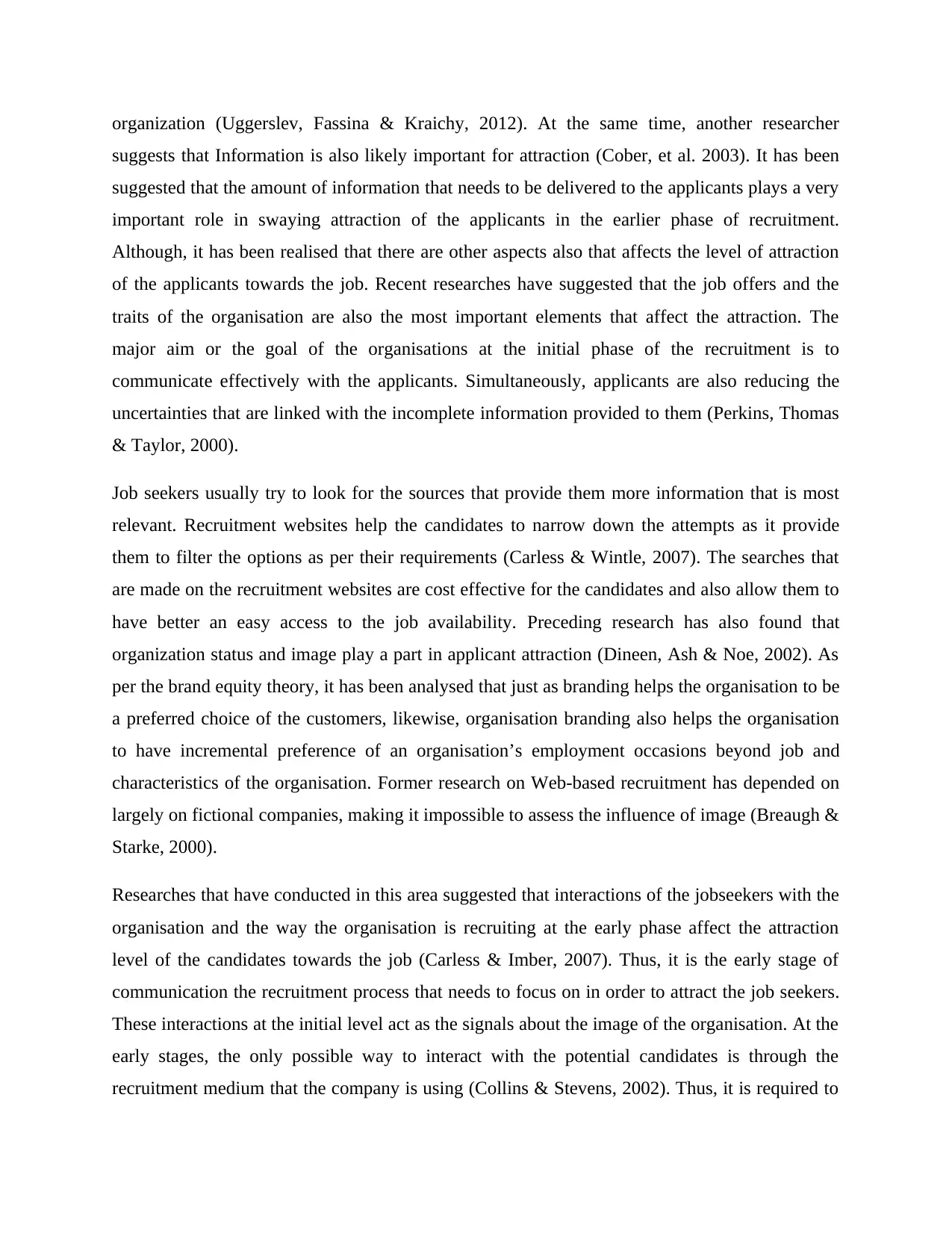
organization (Uggerslev, Fassina & Kraichy, 2012). At the same time, another researcher
suggests that Information is also likely important for attraction (Cober, et al. 2003). It has been
suggested that the amount of information that needs to be delivered to the applicants plays a very
important role in swaying attraction of the applicants in the earlier phase of recruitment.
Although, it has been realised that there are other aspects also that affects the level of attraction
of the applicants towards the job. Recent researches have suggested that the job offers and the
traits of the organisation are also the most important elements that affect the attraction. The
major aim or the goal of the organisations at the initial phase of the recruitment is to
communicate effectively with the applicants. Simultaneously, applicants are also reducing the
uncertainties that are linked with the incomplete information provided to them (Perkins, Thomas
& Taylor, 2000).
Job seekers usually try to look for the sources that provide them more information that is most
relevant. Recruitment websites help the candidates to narrow down the attempts as it provide
them to filter the options as per their requirements (Carless & Wintle, 2007). The searches that
are made on the recruitment websites are cost effective for the candidates and also allow them to
have better an easy access to the job availability. Preceding research has also found that
organization status and image play a part in applicant attraction (Dineen, Ash & Noe, 2002). As
per the brand equity theory, it has been analysed that just as branding helps the organisation to be
a preferred choice of the customers, likewise, organisation branding also helps the organisation
to have incremental preference of an organisation’s employment occasions beyond job and
characteristics of the organisation. Former research on Web-based recruitment has depended on
largely on fictional companies, making it impossible to assess the influence of image (Breaugh &
Starke, 2000).
Researches that have conducted in this area suggested that interactions of the jobseekers with the
organisation and the way the organisation is recruiting at the early phase affect the attraction
level of the candidates towards the job (Carless & Imber, 2007). Thus, it is the early stage of
communication the recruitment process that needs to focus on in order to attract the job seekers.
These interactions at the initial level act as the signals about the image of the organisation. At the
early stages, the only possible way to interact with the potential candidates is through the
recruitment medium that the company is using (Collins & Stevens, 2002). Thus, it is required to
suggests that Information is also likely important for attraction (Cober, et al. 2003). It has been
suggested that the amount of information that needs to be delivered to the applicants plays a very
important role in swaying attraction of the applicants in the earlier phase of recruitment.
Although, it has been realised that there are other aspects also that affects the level of attraction
of the applicants towards the job. Recent researches have suggested that the job offers and the
traits of the organisation are also the most important elements that affect the attraction. The
major aim or the goal of the organisations at the initial phase of the recruitment is to
communicate effectively with the applicants. Simultaneously, applicants are also reducing the
uncertainties that are linked with the incomplete information provided to them (Perkins, Thomas
& Taylor, 2000).
Job seekers usually try to look for the sources that provide them more information that is most
relevant. Recruitment websites help the candidates to narrow down the attempts as it provide
them to filter the options as per their requirements (Carless & Wintle, 2007). The searches that
are made on the recruitment websites are cost effective for the candidates and also allow them to
have better an easy access to the job availability. Preceding research has also found that
organization status and image play a part in applicant attraction (Dineen, Ash & Noe, 2002). As
per the brand equity theory, it has been analysed that just as branding helps the organisation to be
a preferred choice of the customers, likewise, organisation branding also helps the organisation
to have incremental preference of an organisation’s employment occasions beyond job and
characteristics of the organisation. Former research on Web-based recruitment has depended on
largely on fictional companies, making it impossible to assess the influence of image (Breaugh &
Starke, 2000).
Researches that have conducted in this area suggested that interactions of the jobseekers with the
organisation and the way the organisation is recruiting at the early phase affect the attraction
level of the candidates towards the job (Carless & Imber, 2007). Thus, it is the early stage of
communication the recruitment process that needs to focus on in order to attract the job seekers.
These interactions at the initial level act as the signals about the image of the organisation. At the
early stages, the only possible way to interact with the potential candidates is through the
recruitment medium that the company is using (Collins & Stevens, 2002). Thus, it is required to
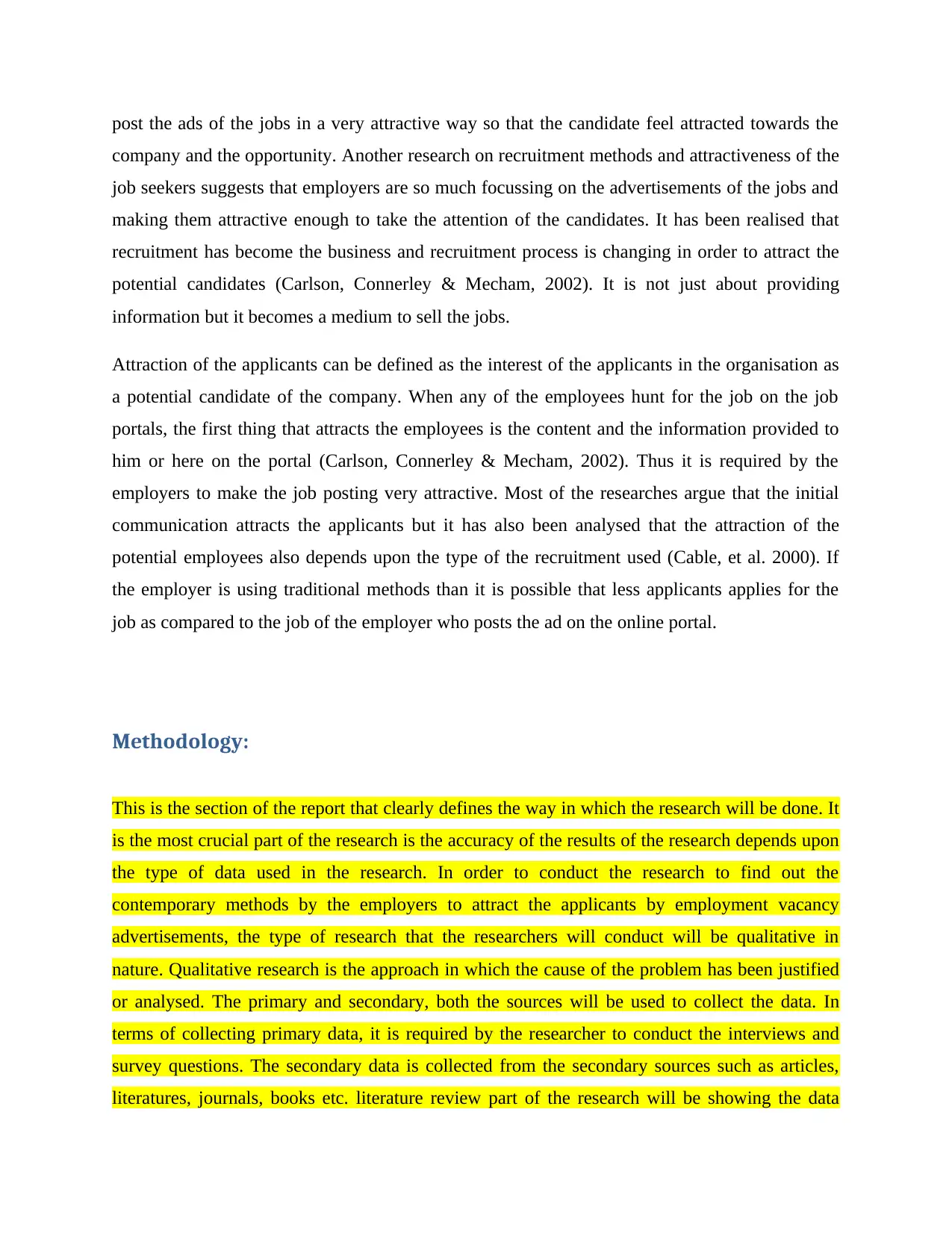
post the ads of the jobs in a very attractive way so that the candidate feel attracted towards the
company and the opportunity. Another research on recruitment methods and attractiveness of the
job seekers suggests that employers are so much focussing on the advertisements of the jobs and
making them attractive enough to take the attention of the candidates. It has been realised that
recruitment has become the business and recruitment process is changing in order to attract the
potential candidates (Carlson, Connerley & Mecham, 2002). It is not just about providing
information but it becomes a medium to sell the jobs.
Attraction of the applicants can be defined as the interest of the applicants in the organisation as
a potential candidate of the company. When any of the employees hunt for the job on the job
portals, the first thing that attracts the employees is the content and the information provided to
him or here on the portal (Carlson, Connerley & Mecham, 2002). Thus it is required by the
employers to make the job posting very attractive. Most of the researches argue that the initial
communication attracts the applicants but it has also been analysed that the attraction of the
potential employees also depends upon the type of the recruitment used (Cable, et al. 2000). If
the employer is using traditional methods than it is possible that less applicants applies for the
job as compared to the job of the employer who posts the ad on the online portal.
Methodology:
This is the section of the report that clearly defines the way in which the research will be done. It
is the most crucial part of the research is the accuracy of the results of the research depends upon
the type of data used in the research. In order to conduct the research to find out the
contemporary methods by the employers to attract the applicants by employment vacancy
advertisements, the type of research that the researchers will conduct will be qualitative in
nature. Qualitative research is the approach in which the cause of the problem has been justified
or analysed. The primary and secondary, both the sources will be used to collect the data. In
terms of collecting primary data, it is required by the researcher to conduct the interviews and
survey questions. The secondary data is collected from the secondary sources such as articles,
literatures, journals, books etc. literature review part of the research will be showing the data
company and the opportunity. Another research on recruitment methods and attractiveness of the
job seekers suggests that employers are so much focussing on the advertisements of the jobs and
making them attractive enough to take the attention of the candidates. It has been realised that
recruitment has become the business and recruitment process is changing in order to attract the
potential candidates (Carlson, Connerley & Mecham, 2002). It is not just about providing
information but it becomes a medium to sell the jobs.
Attraction of the applicants can be defined as the interest of the applicants in the organisation as
a potential candidate of the company. When any of the employees hunt for the job on the job
portals, the first thing that attracts the employees is the content and the information provided to
him or here on the portal (Carlson, Connerley & Mecham, 2002). Thus it is required by the
employers to make the job posting very attractive. Most of the researches argue that the initial
communication attracts the applicants but it has also been analysed that the attraction of the
potential employees also depends upon the type of the recruitment used (Cable, et al. 2000). If
the employer is using traditional methods than it is possible that less applicants applies for the
job as compared to the job of the employer who posts the ad on the online portal.
Methodology:
This is the section of the report that clearly defines the way in which the research will be done. It
is the most crucial part of the research is the accuracy of the results of the research depends upon
the type of data used in the research. In order to conduct the research to find out the
contemporary methods by the employers to attract the applicants by employment vacancy
advertisements, the type of research that the researchers will conduct will be qualitative in
nature. Qualitative research is the approach in which the cause of the problem has been justified
or analysed. The primary and secondary, both the sources will be used to collect the data. In
terms of collecting primary data, it is required by the researcher to conduct the interviews and
survey questions. The secondary data is collected from the secondary sources such as articles,
literatures, journals, books etc. literature review part of the research will be showing the data
⊘ This is a preview!⊘
Do you want full access?
Subscribe today to unlock all pages.

Trusted by 1+ million students worldwide
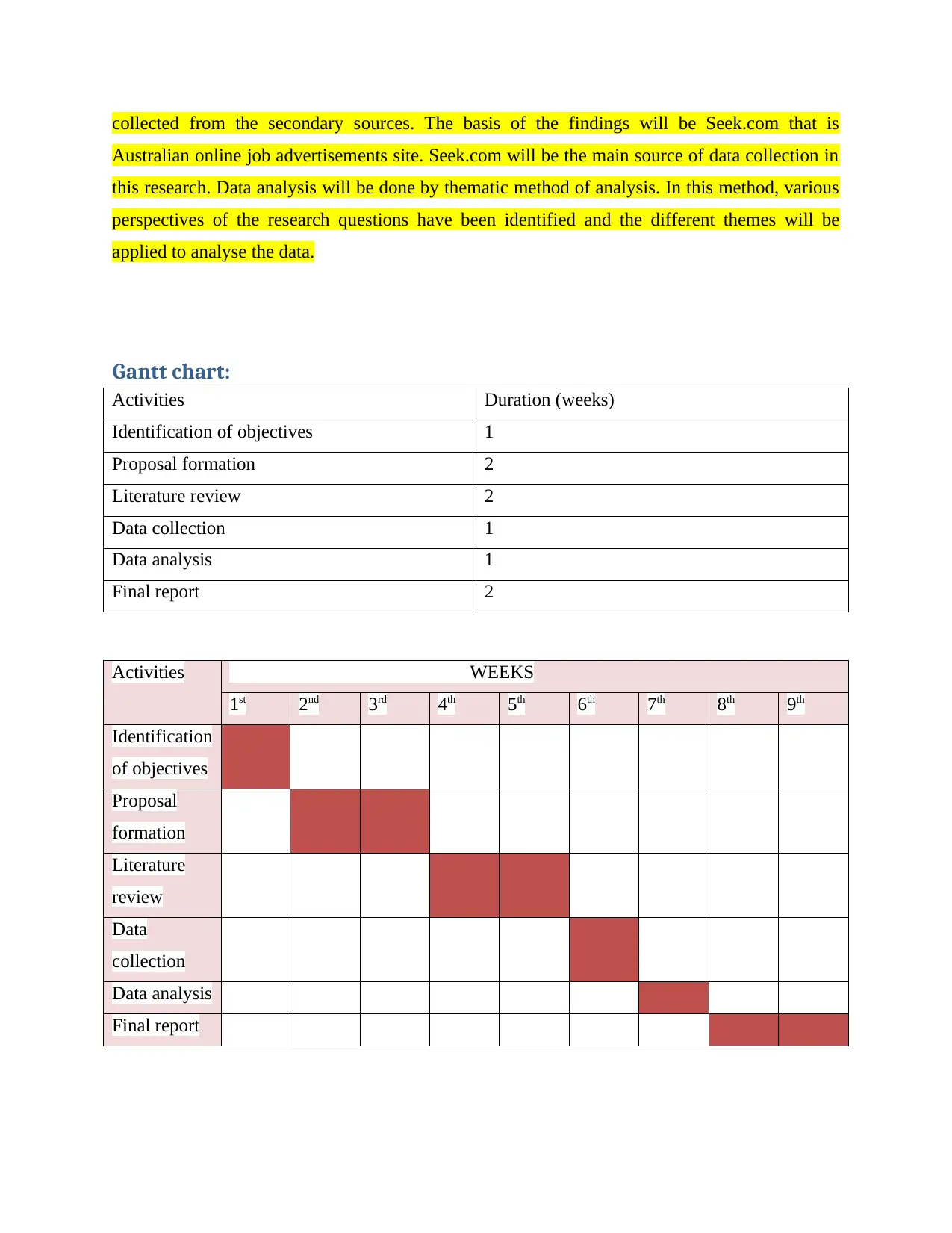
collected from the secondary sources. The basis of the findings will be Seek.com that is
Australian online job advertisements site. Seek.com will be the main source of data collection in
this research. Data analysis will be done by thematic method of analysis. In this method, various
perspectives of the research questions have been identified and the different themes will be
applied to analyse the data.
Gantt chart:
Activities Duration (weeks)
Identification of objectives 1
Proposal formation 2
Literature review 2
Data collection 1
Data analysis 1
Final report 2
Activities WEEKS
1st 2nd 3rd 4th 5th 6th 7th 8th 9th
Identification
of objectives
Proposal
formation
Literature
review
Data
collection
Data analysis
Final report
Australian online job advertisements site. Seek.com will be the main source of data collection in
this research. Data analysis will be done by thematic method of analysis. In this method, various
perspectives of the research questions have been identified and the different themes will be
applied to analyse the data.
Gantt chart:
Activities Duration (weeks)
Identification of objectives 1
Proposal formation 2
Literature review 2
Data collection 1
Data analysis 1
Final report 2
Activities WEEKS
1st 2nd 3rd 4th 5th 6th 7th 8th 9th
Identification
of objectives
Proposal
formation
Literature
review
Data
collection
Data analysis
Final report
Paraphrase This Document
Need a fresh take? Get an instant paraphrase of this document with our AI Paraphraser
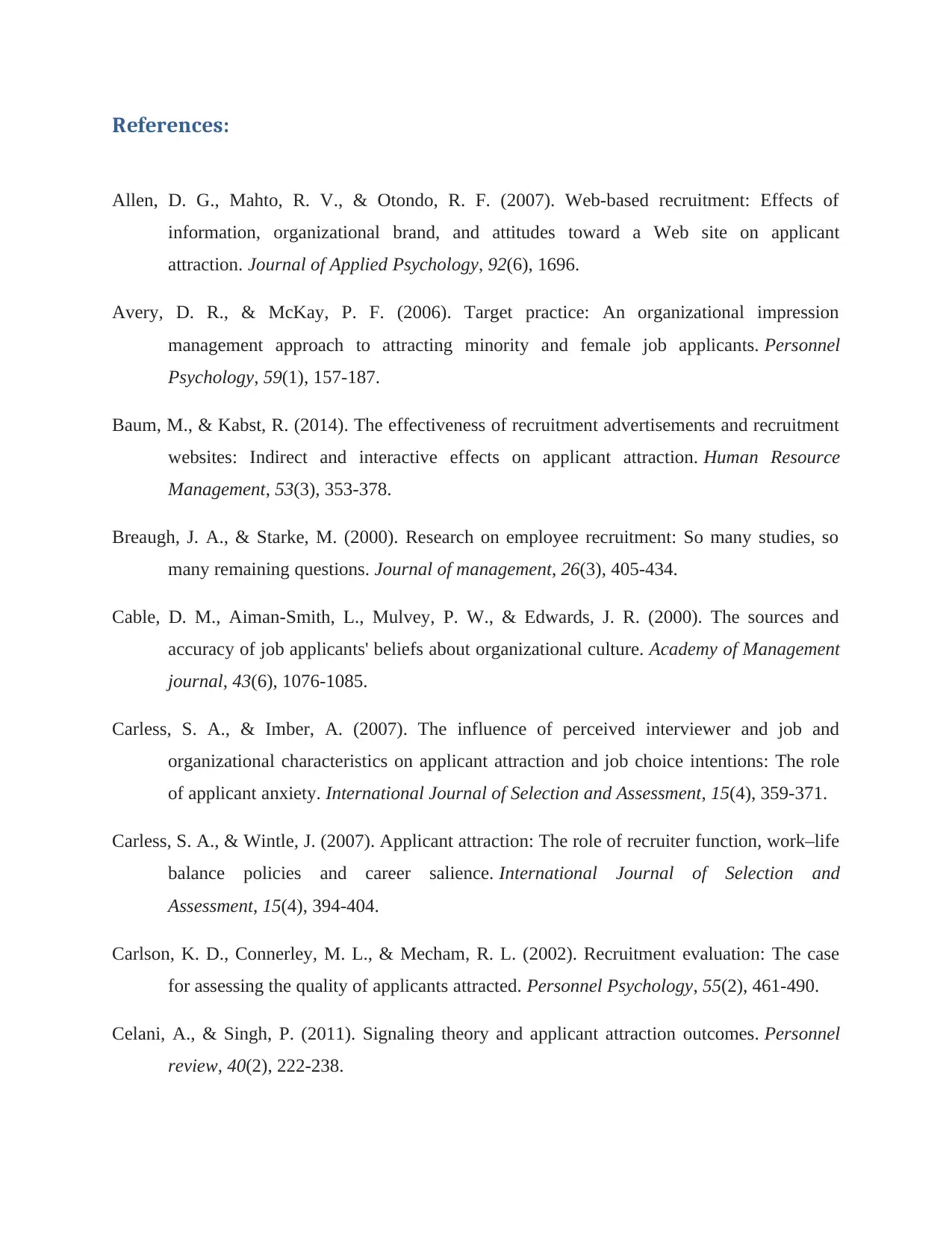
References:
Allen, D. G., Mahto, R. V., & Otondo, R. F. (2007). Web-based recruitment: Effects of
information, organizational brand, and attitudes toward a Web site on applicant
attraction. Journal of Applied Psychology, 92(6), 1696.
Avery, D. R., & McKay, P. F. (2006). Target practice: An organizational impression
management approach to attracting minority and female job applicants. Personnel
Psychology, 59(1), 157-187.
Baum, M., & Kabst, R. (2014). The effectiveness of recruitment advertisements and recruitment
websites: Indirect and interactive effects on applicant attraction. Human Resource
Management, 53(3), 353-378.
Breaugh, J. A., & Starke, M. (2000). Research on employee recruitment: So many studies, so
many remaining questions. Journal of management, 26(3), 405-434.
Cable, D. M., Aiman-Smith, L., Mulvey, P. W., & Edwards, J. R. (2000). The sources and
accuracy of job applicants' beliefs about organizational culture. Academy of Management
journal, 43(6), 1076-1085.
Carless, S. A., & Imber, A. (2007). The influence of perceived interviewer and job and
organizational characteristics on applicant attraction and job choice intentions: The role
of applicant anxiety. International Journal of Selection and Assessment, 15(4), 359-371.
Carless, S. A., & Wintle, J. (2007). Applicant attraction: The role of recruiter function, work–life
balance policies and career salience. International Journal of Selection and
Assessment, 15(4), 394-404.
Carlson, K. D., Connerley, M. L., & Mecham, R. L. (2002). Recruitment evaluation: The case
for assessing the quality of applicants attracted. Personnel Psychology, 55(2), 461-490.
Celani, A., & Singh, P. (2011). Signaling theory and applicant attraction outcomes. Personnel
review, 40(2), 222-238.
Allen, D. G., Mahto, R. V., & Otondo, R. F. (2007). Web-based recruitment: Effects of
information, organizational brand, and attitudes toward a Web site on applicant
attraction. Journal of Applied Psychology, 92(6), 1696.
Avery, D. R., & McKay, P. F. (2006). Target practice: An organizational impression
management approach to attracting minority and female job applicants. Personnel
Psychology, 59(1), 157-187.
Baum, M., & Kabst, R. (2014). The effectiveness of recruitment advertisements and recruitment
websites: Indirect and interactive effects on applicant attraction. Human Resource
Management, 53(3), 353-378.
Breaugh, J. A., & Starke, M. (2000). Research on employee recruitment: So many studies, so
many remaining questions. Journal of management, 26(3), 405-434.
Cable, D. M., Aiman-Smith, L., Mulvey, P. W., & Edwards, J. R. (2000). The sources and
accuracy of job applicants' beliefs about organizational culture. Academy of Management
journal, 43(6), 1076-1085.
Carless, S. A., & Imber, A. (2007). The influence of perceived interviewer and job and
organizational characteristics on applicant attraction and job choice intentions: The role
of applicant anxiety. International Journal of Selection and Assessment, 15(4), 359-371.
Carless, S. A., & Wintle, J. (2007). Applicant attraction: The role of recruiter function, work–life
balance policies and career salience. International Journal of Selection and
Assessment, 15(4), 394-404.
Carlson, K. D., Connerley, M. L., & Mecham, R. L. (2002). Recruitment evaluation: The case
for assessing the quality of applicants attracted. Personnel Psychology, 55(2), 461-490.
Celani, A., & Singh, P. (2011). Signaling theory and applicant attraction outcomes. Personnel
review, 40(2), 222-238.
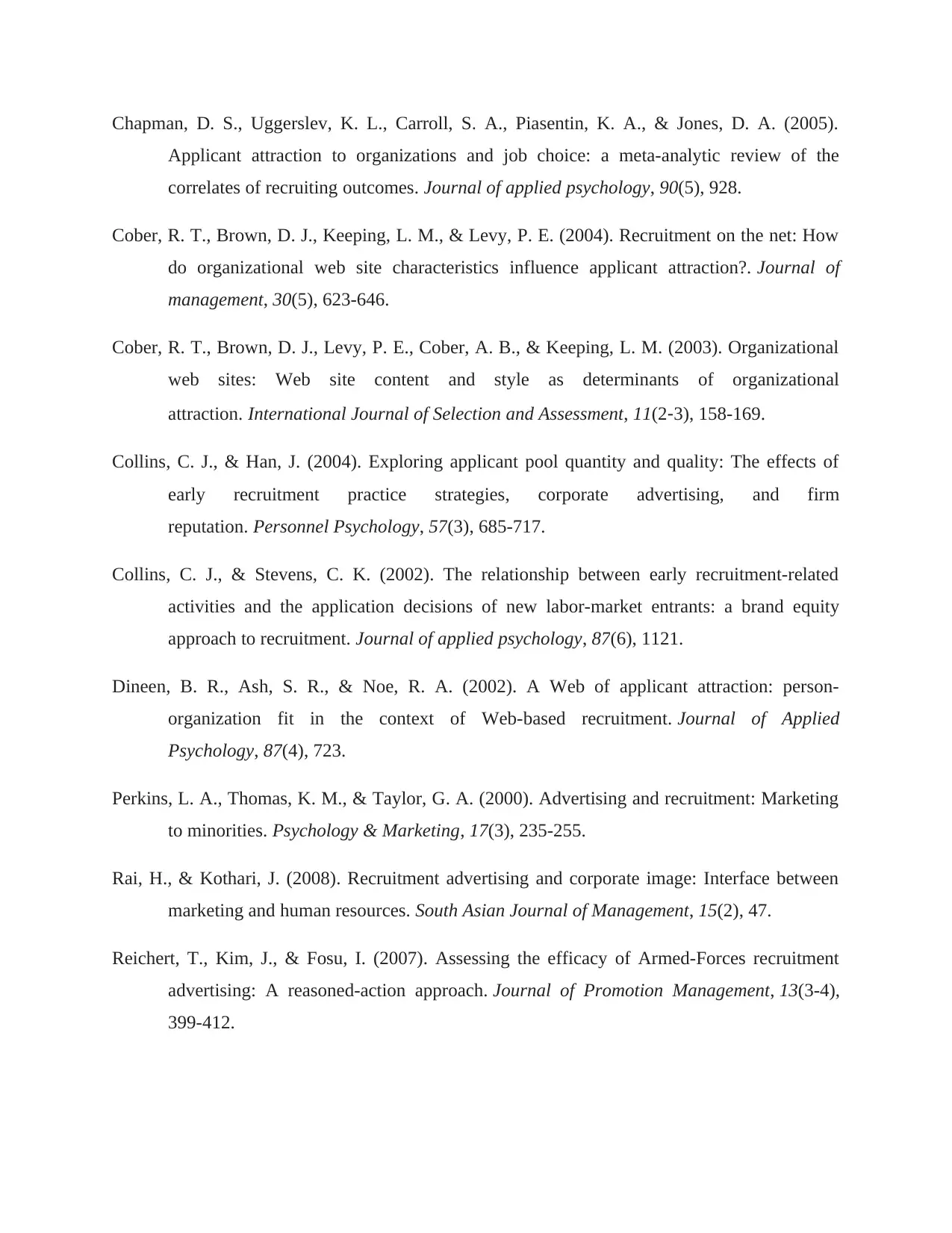
Chapman, D. S., Uggerslev, K. L., Carroll, S. A., Piasentin, K. A., & Jones, D. A. (2005).
Applicant attraction to organizations and job choice: a meta-analytic review of the
correlates of recruiting outcomes. Journal of applied psychology, 90(5), 928.
Cober, R. T., Brown, D. J., Keeping, L. M., & Levy, P. E. (2004). Recruitment on the net: How
do organizational web site characteristics influence applicant attraction?. Journal of
management, 30(5), 623-646.
Cober, R. T., Brown, D. J., Levy, P. E., Cober, A. B., & Keeping, L. M. (2003). Organizational
web sites: Web site content and style as determinants of organizational
attraction. International Journal of Selection and Assessment, 11(2‐3), 158-169.
Collins, C. J., & Han, J. (2004). Exploring applicant pool quantity and quality: The effects of
early recruitment practice strategies, corporate advertising, and firm
reputation. Personnel Psychology, 57(3), 685-717.
Collins, C. J., & Stevens, C. K. (2002). The relationship between early recruitment-related
activities and the application decisions of new labor-market entrants: a brand equity
approach to recruitment. Journal of applied psychology, 87(6), 1121.
Dineen, B. R., Ash, S. R., & Noe, R. A. (2002). A Web of applicant attraction: person-
organization fit in the context of Web-based recruitment. Journal of Applied
Psychology, 87(4), 723.
Perkins, L. A., Thomas, K. M., & Taylor, G. A. (2000). Advertising and recruitment: Marketing
to minorities. Psychology & Marketing, 17(3), 235-255.
Rai, H., & Kothari, J. (2008). Recruitment advertising and corporate image: Interface between
marketing and human resources. South Asian Journal of Management, 15(2), 47.
Reichert, T., Kim, J., & Fosu, I. (2007). Assessing the efficacy of Armed-Forces recruitment
advertising: A reasoned-action approach. Journal of Promotion Management, 13(3-4),
399-412.
Applicant attraction to organizations and job choice: a meta-analytic review of the
correlates of recruiting outcomes. Journal of applied psychology, 90(5), 928.
Cober, R. T., Brown, D. J., Keeping, L. M., & Levy, P. E. (2004). Recruitment on the net: How
do organizational web site characteristics influence applicant attraction?. Journal of
management, 30(5), 623-646.
Cober, R. T., Brown, D. J., Levy, P. E., Cober, A. B., & Keeping, L. M. (2003). Organizational
web sites: Web site content and style as determinants of organizational
attraction. International Journal of Selection and Assessment, 11(2‐3), 158-169.
Collins, C. J., & Han, J. (2004). Exploring applicant pool quantity and quality: The effects of
early recruitment practice strategies, corporate advertising, and firm
reputation. Personnel Psychology, 57(3), 685-717.
Collins, C. J., & Stevens, C. K. (2002). The relationship between early recruitment-related
activities and the application decisions of new labor-market entrants: a brand equity
approach to recruitment. Journal of applied psychology, 87(6), 1121.
Dineen, B. R., Ash, S. R., & Noe, R. A. (2002). A Web of applicant attraction: person-
organization fit in the context of Web-based recruitment. Journal of Applied
Psychology, 87(4), 723.
Perkins, L. A., Thomas, K. M., & Taylor, G. A. (2000). Advertising and recruitment: Marketing
to minorities. Psychology & Marketing, 17(3), 235-255.
Rai, H., & Kothari, J. (2008). Recruitment advertising and corporate image: Interface between
marketing and human resources. South Asian Journal of Management, 15(2), 47.
Reichert, T., Kim, J., & Fosu, I. (2007). Assessing the efficacy of Armed-Forces recruitment
advertising: A reasoned-action approach. Journal of Promotion Management, 13(3-4),
399-412.
⊘ This is a preview!⊘
Do you want full access?
Subscribe today to unlock all pages.

Trusted by 1+ million students worldwide
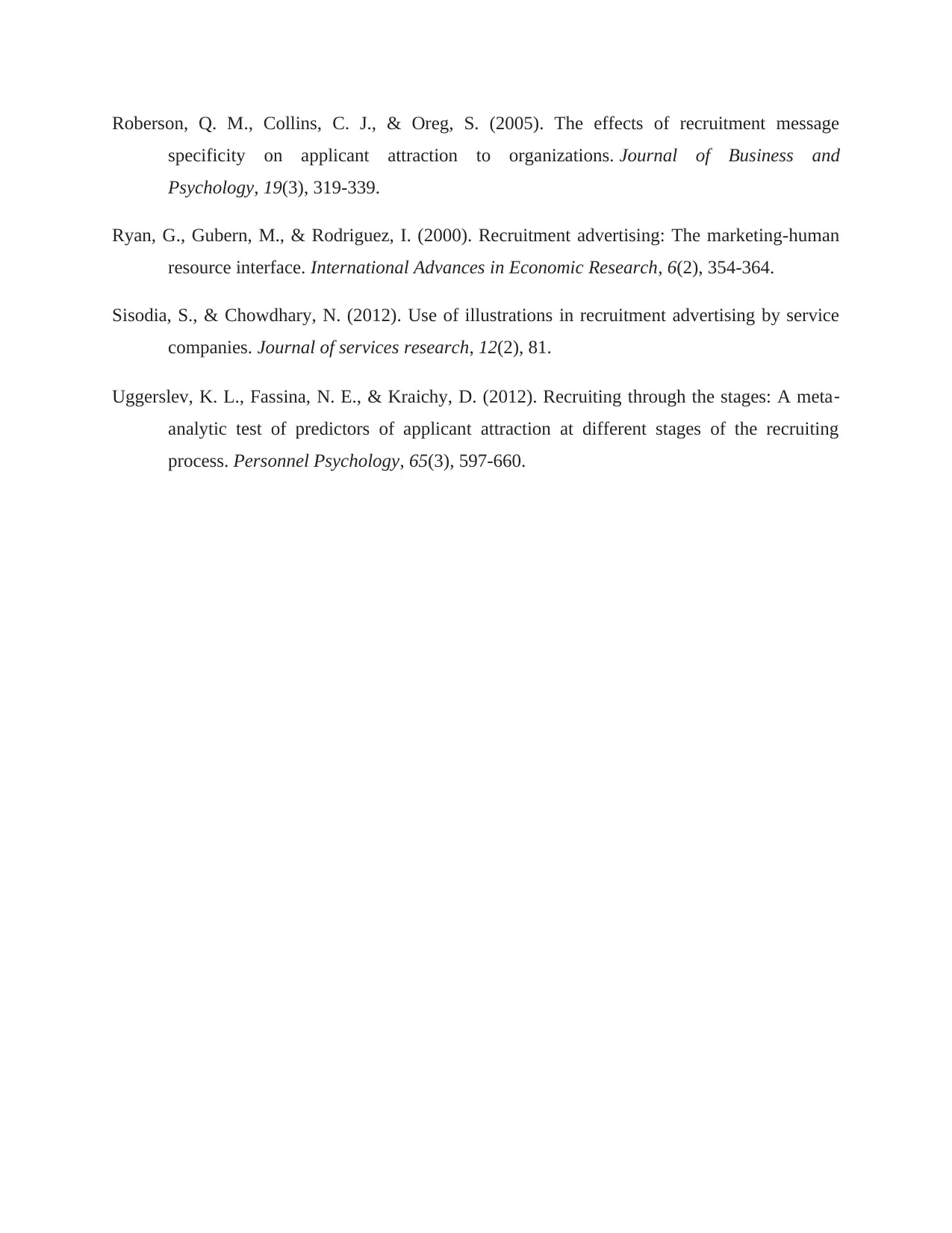
Roberson, Q. M., Collins, C. J., & Oreg, S. (2005). The effects of recruitment message
specificity on applicant attraction to organizations. Journal of Business and
Psychology, 19(3), 319-339.
Ryan, G., Gubern, M., & Rodriguez, I. (2000). Recruitment advertising: The marketing-human
resource interface. International Advances in Economic Research, 6(2), 354-364.
Sisodia, S., & Chowdhary, N. (2012). Use of illustrations in recruitment advertising by service
companies. Journal of services research, 12(2), 81.
Uggerslev, K. L., Fassina, N. E., & Kraichy, D. (2012). Recruiting through the stages: A meta‐
analytic test of predictors of applicant attraction at different stages of the recruiting
process. Personnel Psychology, 65(3), 597-660.
specificity on applicant attraction to organizations. Journal of Business and
Psychology, 19(3), 319-339.
Ryan, G., Gubern, M., & Rodriguez, I. (2000). Recruitment advertising: The marketing-human
resource interface. International Advances in Economic Research, 6(2), 354-364.
Sisodia, S., & Chowdhary, N. (2012). Use of illustrations in recruitment advertising by service
companies. Journal of services research, 12(2), 81.
Uggerslev, K. L., Fassina, N. E., & Kraichy, D. (2012). Recruiting through the stages: A meta‐
analytic test of predictors of applicant attraction at different stages of the recruiting
process. Personnel Psychology, 65(3), 597-660.
1 out of 10
Related Documents
Your All-in-One AI-Powered Toolkit for Academic Success.
+13062052269
info@desklib.com
Available 24*7 on WhatsApp / Email
![[object Object]](/_next/static/media/star-bottom.7253800d.svg)
Unlock your academic potential
Copyright © 2020–2025 A2Z Services. All Rights Reserved. Developed and managed by ZUCOL.





